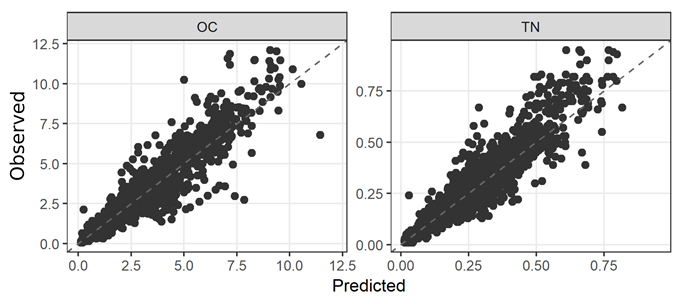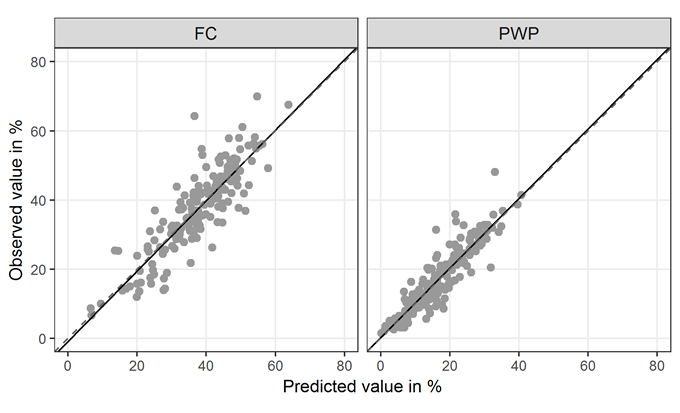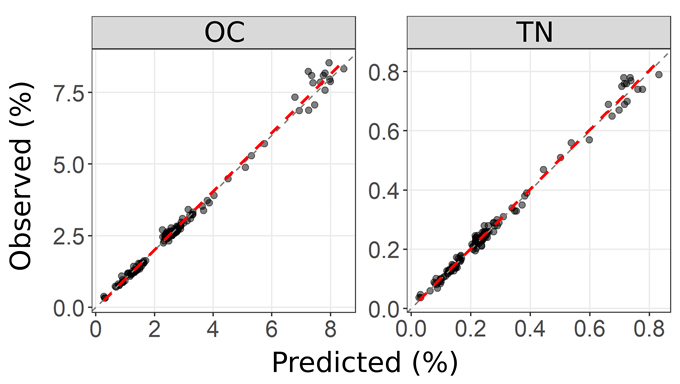Recent progress in soil spectroscopy
Soil spectroscopy has been an area of research for the Manaaki Whenua pedometrics research team for a number of years now.
Soil spectroscopy relates the fraction of reflected light from a soil surface and received by the instrument at a range of wavelengths to absorbance features due to the arrangements of molecules containing oxygen, hydrogen, carbon, or nitrogen atoms. The recorded spectra are then used by a statistical model to provide a quantitative estimate of a given soil property. Two different soil spectroscopy technologies are currently in use at Manaaki Whenua: visible near-infrared spectroscopy (VNIR) records soil reflectance between 350 and 2,500 nm, while mid-infrared spectroscopy (MIR) goes a lot further in the infrared part of the electro-magnetic spectrum.
Visible near-infrared spectroscopy
We have been researching VNIR for almost 10 years, and over this time we have recorded a large number of soil spectra. The result is a suite of quantitative prediction models for different soil properties. Work initially focussed on soil organic carbon and total nitrogen, which resulted in a spectral library of more than 7,000 records for these two properties, that would typically be measured using a LECO Analyser that combusts the soil at high temperature to determine total carbon and total nitrogen. The prediction model for carbon has been improving over the years, and the average prediction error is now below 1%, with an R2 of 0.90 on an independent validation set. For nitrogen, validation results are similar, with an average prediction error of 0.06%, and an R2 of 0.89. The prediction of clay content was also attempted, although the size of the spectral library for this attribute is significantly smaller (n = 2177). While results are not as good as carbon or nitrogen, the average error below 4% (R2 = 0.86) is very encouraging, given the reference method for measuring clay content is extremely costly and tedious (Fig. 1).

Figure 1. Scatterplots of VNIR observed vs. predicted values for organic carbon and nitrogen.
Soil organic carbon, total nitrogen, and clay content are attributes whose prediction by VNIR are well documented in the literature. More recently, however, other attributes, harder to measure and model, have been attempted. In a recent paper, the prediction of available water-holding capacity (AWC) is documented. This work was part of our irrigation research because AWC is a key soil attribute that quantifies the amount of plant available water a soil can store. It is calculated as the difference between field capacity (FC) and permanent wilting point (PWP), and conventionally estimated by applying a known controlled pressure to an intact soil core, which requires sophisticated soil physics apparatus and is time and cost consuming. Results of the analysis of almost 1,000 AWC measurements showed that it was possible to predict PWP and FC within very reasonable uncertainties (the average error on the AWC of an independent validation set was below 5%). This demonstrates the potential of VNIR spectroscopy to provide a quick and accurate determination of AWC for New Zealand. It also creates an opportunity to generate many more estimates of AWC, an attribute historically difficult and expensive to measure, and to produce high-resolution maps of AWC, thereby enabling a step change in sustainable land management and effective irrigation planning (Fig. 2.)

Figure 2. Scatterplots of observed vs. predicted values for PWP and FC.
Mid-infrared spectroscopy
Mid-infrared spectroscopy (MIR), in contrast to VNIR spectroscopy, is a more recent addition to our range of proximal soil sensing instruments. Preliminary work is underway to assess the ability of MIR to predict soil organic carbon and total nitrogen. To date, we have collected data from soils collected from agricultural fields on four different farms. Results show a drastic improvement on VNIR results, with R2 of 0.99 and 0.98 for carbon and nitrogen respectively. However, it is worth noting that sample preparation is more involved than VNIR, with spectra being recorded from finely ground soil, as opposed to 2 mm sieved soil (Fig. 3).

Figure 3. Scatterplots of observed vs. predicted values for soil carbon (OC) and total nitrogen (TN) using MIR spectroscopy.
Further reading
Blaschek M, Roudier P, Poggio M, Hedley CB 2019. Prediction of soil available water-holding capacity from visible near-infrared reflectance spectra. Scientific Reports, 9.

